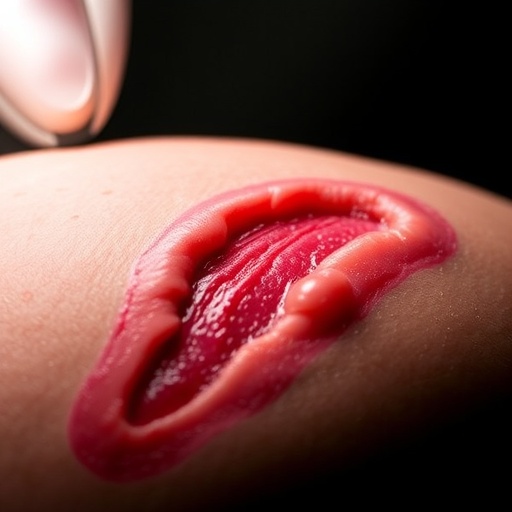In recent years, nipple-sparing mastectomy (NSM) combined with autologous tissue reconstruction has gained traction in breast cancer surgery for its ability to preserve the breast’s natural appearance while effectively managing malignancy. Among the reconstruction options, the deep inferior epigastric perforator (DIEP) flap stands out due to its muscle-sparing technique and favorable aesthetic outcomes. However, despite advancements in surgical methods, one persistent complication—skin necrosis—continues to challenge surgeons performing NSM with DIEP reconstruction. A groundbreaking study recently published in BMC Cancer sheds light on a critical surgical factor contributing to this complication: the length of the circumferential periareolar incision.
This comprehensive retrospective analysis involved 61 patients who underwent NSM followed by DIEP flap reconstruction over a three-year span, between 2020 and 2023. The research team meticulously gathered data encompassing patient demographics, breast tissue characteristics, types and extents of surgical incisions, and postoperative outcomes focused specifically on the development of skin necrosis in the mastectomy skin flap or nipple-areola complex (NAC). Their exploration unveiled a significant correlation between the length of the periareolar incision and the incidence of necrosis, identifying an incision length exceeding 30% of the periareolar circumference as a notable threshold for increased risk.
Skin necrosis remains a feared complication in breast reconstruction surgeries due to its potential to compromise the surgical aesthetic, delay adjuvant treatments, and elevate the risk of infections or further surgeries. Despite efforts to optimize surgical techniques, skin flap viability is often influenced by factors such as incision design, blood supply, and patient characteristics. The findings of this study emphasize the crucial role of surgical planning, particularly concerning the geometric design of the incision surrounding the nipple-areola complex.
The study reported an overall skin necrosis rate of 42.6%, a statistic that underscores the clinical relevance of the problem. Notably, patients with periareolar incisions extending beyond 30% of the circumferential length experienced a staggering 57.1% occurrence of necrosis, compared to a markedly lower 30.3% in those with shorter incisions. This significant disparity illuminates the biomechanical and vascular implications of extended incisions in this anatomical area, where blood supply is delicate and highly susceptible to disruption.
Interestingly, the study also evaluated a variety of potential risk factors—such as body mass index (BMI), degree of breast ptosis, patient age, year of reconstruction, and receipt of neoadjuvant chemotherapy—but found no significant association between these variables and skin necrosis risk. This delineation of incision length as an independent risk factor refines the surgical risk profile and directs attention toward modifiable intraoperative decisions.
The pathophysiological underpinnings of how extended circumferential periareolar incisions contribute to necrosis likely relate to the compromise of subdermal and subcutaneous microvascular networks essential for tissue viability. The nipple-areola complex receives blood supply predominantly from perforators emanating from the internal mammary artery and lateral thoracic vessels, with delicate anastomoses maintaining the skin flap’s health. Lengthy incisions may sever these critical channels, diminishing perfusion and triggering ischemic injury, a hypothesis supported by clinical observations in this study.
Surgeons performing NSM with DIEP flap reconstruction thus face a surgical conundrum: balancing the need for adequate exposure to prepare recipient vessels for flap anastomosis against the imperative to preserve skin perfusion. The research suggests favoring minimal incision lengths, ideally less than 30% of the periareolar circumference, to safeguard the vascular integrity of the mastectomy skin flap and NAC. Strategic incision planning tailored individually to breast size and shape, along with meticulous microsurgical technique, may improve outcomes.
Beyond incision length, the results prompt a reevaluation of surgical training and protocols to emphasize vascular preservation strategies. Enhanced intraoperative imaging technologies, such as indocyanine green angiography, may play an increasing role in assessing real-time perfusion before finalizing incisions and closure. Additionally, adjunctive approaches like hyperbaric oxygen therapy remain speculative but potentially beneficial in high-risk cases identified pre- or intraoperatively.
This study also offers a platform for future research exploring the complex interplay of anatomical variance, surgical technique, and perioperative management on NSM outcomes. While patient factors like BMI and chemotherapy exposure showed no direct correlation with necrosis risk in this cohort, larger multicenter studies are warranted to validate these findings and explore genetic or molecular contributors to tissue ischemia and healing capacity.
The implications of these findings extend beyond immediate surgical outcomes; skin necrosis often results in protracted recovery, psychological distress, and financial burdens for patients, impacting overall quality of life after breast cancer treatment. Optimizing surgical variables like incision length can ultimately improve cosmesis, reduce complication rates, and preserve the psychological benefits of nipple preservation.
In light of this evidence, multidisciplinary breast teams should incorporate these insights into preoperative planning, patient counseling, and surgical technique refinement. Personalized care paradigms integrating anatomical assessments, imaging modalities, and collaborative decision-making may empower surgeons to mitigate necrosis risks effectively while retaining the reconstructive advantages of DIEP flaps.
As the landscape of breast cancer surgery evolves with innovations in oncologic safety and reconstructive artistry, the study’s revelations serve as a pivotal reminder that surgical precision at the microvascular and geometric level remains foundational. By prioritizing minimized circumferential periareolar incisions—ideally below the critical 30% cutoff—surgeons can enhance the viability of mastectomy skin flaps and maintain the nipple-areola complex, ensuring superior aesthetic and functional results for patients.
The revelations from this investigation bring to the forefront an underappreciated yet tangible factor influencing postoperative outcomes. The delicate equilibrium between adequate surgical access and preservation of vascular integrity will continue to shape surgical standards and patient expectations in nipple-sparing mastectomy with autologous reconstruction. The challenge now lies in translating these findings into widespread clinical practice and fostering advances that further mitigate the risk of necrosis without compromising oncologic or reconstructive goals.
Ultimately, this landmark study enriches the collective understanding of risk stratification in NSM and underscores the need for ongoing research integrating surgical innovation, vascular biology, and patient-centered care. With these insights, the goal of achieving safe, durable, and aesthetically pleasing breast reconstruction after cancer treatment becomes increasingly attainable. Surgeons, patients, and healthcare systems stand to benefit when meticulous attention to incision design becomes standard practice, reducing complications and elevating the quality of life for breast cancer survivors.
Subject of Research:
Risk factors for skin necrosis following nipple-sparing mastectomy with deep inferior epigastric perforator flap reconstruction, specifically focusing on the impact of circumferential periareolar incision length.
Article Title:
Circumferential periareolar incision length as a risk factor for skin necrosis after nipple-sparing mastectomy with deep inferior epigastric perforator flap reconstruction.
Article References:
Guo, X., Gong, X., Yang, Y. et al. Circumferential periareolar incision length as a risk factor for skin necrosis after nipple-sparing mastectomy with deep inferior epigastric perforator flap reconstruction. BMC Cancer 25, 1592 (2025). https://doi.org/10.1186/s12885-025-15058-z
Image Credits:
Scienmag.com
DOI:
https://doi.org/10.1186/s12885-025-15058-z
Tags: aesthetic outcomes of DIEP flapautologous tissue reconstruction methodsbreast cancer surgery techniquesbreast surgery research studycircumferential periareolar incision lengthDIEP flap surgical outcomesmastectomy skin flap analysisnipple-sparing mastectomy complicationspatient demographics in mastectomypostoperative outcomes in breast surgeryrisk factors for skin necrosisskin necrosis in breast reconstruction





